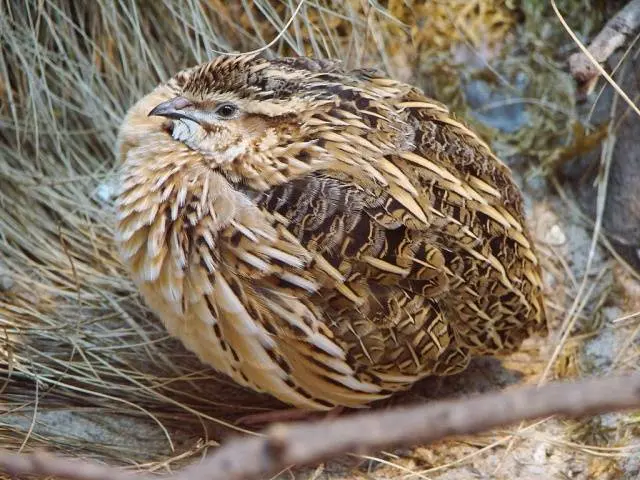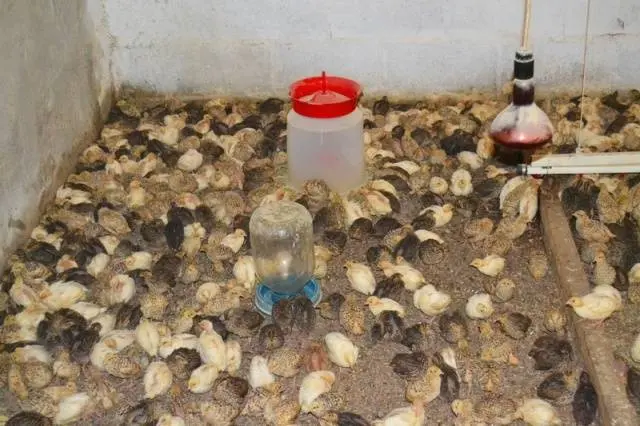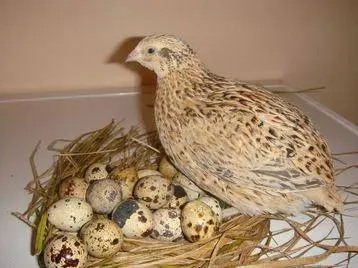Contents
At the moment, many people are starting to show interest in breeding birds. They are especially interested in quails. And if you are reading this article, then you are probably interested in this too. The thing is that quails are unpretentious and their maintenance does not require a lot of space. But there are a lot of benefits from them. Everyone knows how useful quail eggs are. And their meat is tender and tasty. Breeding these birds is very profitable.
However, in the process, you will have many questions, one of which is how to feed quails at home? This is logical, because a lot of things depend on the diet of birds. From this article you will learn what the composition of the quail food is, how many times a day they can be fed, seasonal feeding and much more.

Industrial feed
The first option that you may have is feeding with compound feed. This is a great option, as they contain a complex of useful vitamins for quails, both laying hens and meat. Depending on this, the composition of the feed for quails changes. If we talk about compound feeds of branded production, then several types can be noted:
- Known to all compound feed PK-5. Its main part is corn and wheat. There is a small amount of fishmeal, animal fat and soybean or sunflower meal. Salt, chalk and various kinds of phosphates are used as mineral additives. Lysine among the components must be present without fail. The percentage of components is as follows: proteins – 35% no less, minerals – 5%, the number of grains – 60%. Given the composition of feed for quails, you need to feed about 30 g throughout the day for each quail.

- PK-1 and PK-2. It contains corn and wheat, as well as a small amount of chalk and salt. Fish or bone meal and soybean meal are used as a protein base. Wheat bran or a little barley is added to this type of feed. PC-1 and PC-2 are considered one of the simplest and cheapest quail formulations. The daily norm for one adult bird is 27 g.
- PK-2.2, PK-6 and PK-4. Feed is used for mature adult quails. The percentage of components is as follows: cereals – 60%, protein – 30% and minerals – 10%. Corn, wheat and barley are added as grains in equal proportions. The protein is fish meal, meal, lysine and fodder yeast. Minerals include chalk, salt and phosphate. Sometimes wheat flour, bran and seashells are added to the composition.

Compound feed for quails of own production
Many experienced poultry farmers have gained a lot of experience in feeding quails. Because of this, they have developed their own feed recipes that are ideal for quails. As usual, the main component is cereals. Additional elements are fruits and vegetables or peelings from them. During production, the products are washed well, all damaged parts are removed. After that, the composition is boiled for about 40 minutes. After cooling, everything is crushed to make porridge.

Vegetables and fruits in the feed are an excellent source of trace elements. Thanks to them, quails get a healthy diet, and as a result, their meat becomes even tastier, and the quality of eggs increases. You can even add vegetables to industrial feeds.
Making compound feed for quails with your own hands is quite simple:
- Crush 1 kg of wheat, 400 g of corn and 100 g of barley.
- Add 1 tsp to the composition. bone meal and half tsp. unrefined vegetable oil.
- To saturate the feed with minerals, add 1 tsp. salt, chalk and shells.
- The resulting feed is enough to feed one head for 1.5 months. You can give the quails dry food or wash it with water until it becomes gruel.
- Cottage cheese, fish or minced meat can serve as a source of protein. As vitamins and minerals in do-it-yourself quail food, use fresh herbs and crushed eggshells.
In fact, the food eaten by quails can be different. All components in the recipe can change, it depends on the situation.
Keeping and feeding quails in season
What you feed the quails plays an important role. Some fatten quails until they drop so they grow faster. But, this is not always correct. Quail should be fed regularly, 3-4 times a day. This is done at regular intervals. You can’t fill the feeder with the daily allowance of food and go on business. If you feed growing quails, then you need to make sure that they eat enough. They grow quickly and cannot stand interruptions in feeding.

For the first week, quails need to be fed with boiled eggs. They need to be rubbed with the shell. On the second day, 2 g of cottage cheese is added to the feed for each bird. On the third day, include fresh herbs in the feed. On the fourth day, the number of eggs should be reduced by adding more cottage cheese to the feed. Young animals need to be fed at least 5 times a day. Starting from the second week, you can give the youngsters the usual feed for quails.
It is necessary to distribute food for adult quails so that most of it remains for evening feeding. Grain feed, which takes longer to digest, is suitable for this. Thus, the birds will always be full. There must be water in the drinker. The table below shows how much and what elements a quail should receive from feed.

Feeding the laying hens
Feed for laying hens must be selected very carefully. It should contain a balanced amount of essential vitamins and minerals. Laying hens need a sufficient amount of proteins, carbohydrates and fats. Taking all this into account when selecting feed, high egg production results can be achieved.
The diet of laying hens should consist of 25% protein. This is very important for the full formation of eggs. Also, with such nutrition, the number of eggs laid will increase significantly. The daily feed intake for laying quails is 25–30 g. If the amount of feed is insufficient, the quails will simply stop laying. Usually, the highest performance of laying hens lasts up to 11 months of life. Keeping quail longer is not advised. So up to a year they are slaughtered for meat.

Quail fattening for meat
Usually quails with physical defects, quails after oviposition, or individuals specially grown for this purpose are fattened for meat. Such feeding is introduced gradually. A sharply increased amount of food can even kill the bird. Males and females should be kept separately, preferably placed in separate cages.
For fattening chicks, quails use the same amount of food as for a large bird. Gradually, you need to add more fats and corn to the quail feed. You can prepare feed from compound feed for broilers and peas (about 20%). Peas must be boiled for 30-40 minutes.

Remember that it is possible to completely transfer quails to a new food only after 4 days. The first few days you just need to add new food to the old one, gradually increasing its amount. Such feeding should continue for a month. During this time, the amount of feed consumed should increase by 8%. When all requirements are met, a fattened quail should weigh about 150-160 grams.
Checking the correct diet
To check whether quails are eating properly, you need to weigh the birds from time to time. Attention! An ordinary quail should weigh about 2 grams by 100 months, and meat breed birds should weigh 160 grams.
Subject to the rules of feeding, the quail should have a large amount of subcutaneous fat on the chest. If the indicators after weighing do not match, it is worth reviewing the composition of the feed or replacing it with another one.

Conclusion
So, we saw how to properly feed quails at home, learned how to prepare food for chicks, laying hens and adults on our own. As the data show, quails grow very quickly and do not need large amounts of feed. The main rule is to feed the quail often and use the right food. The feed should contain all the substances necessary for growth and weight gain. Birds should always be full, the number of eggs laid by laying hens depends on this. By following these simple rules, you can succeed in growing quails.












waar kry n mens die kos vir die kwartels ek is nog nuut in die game as iemand my Kan help